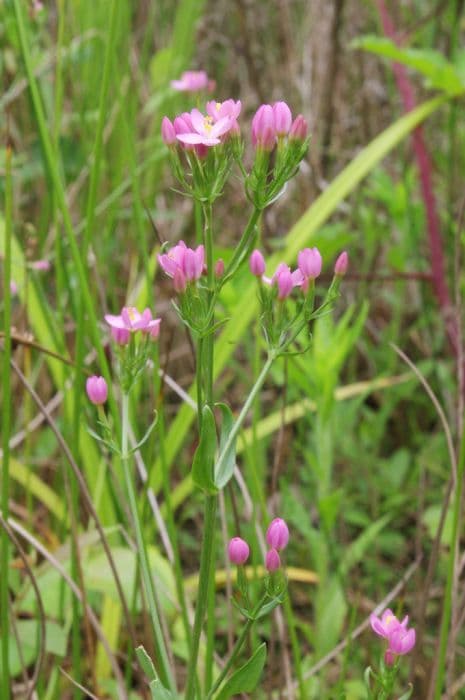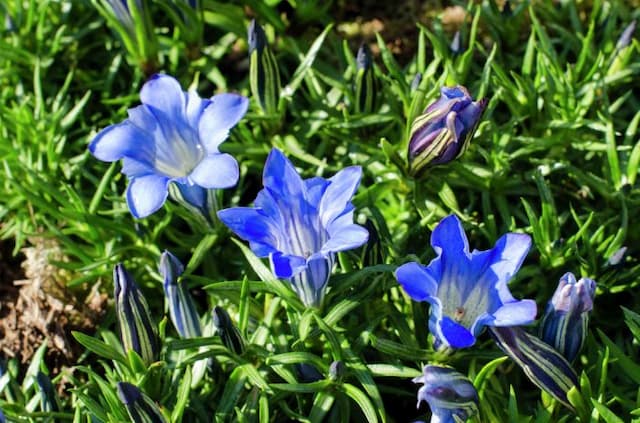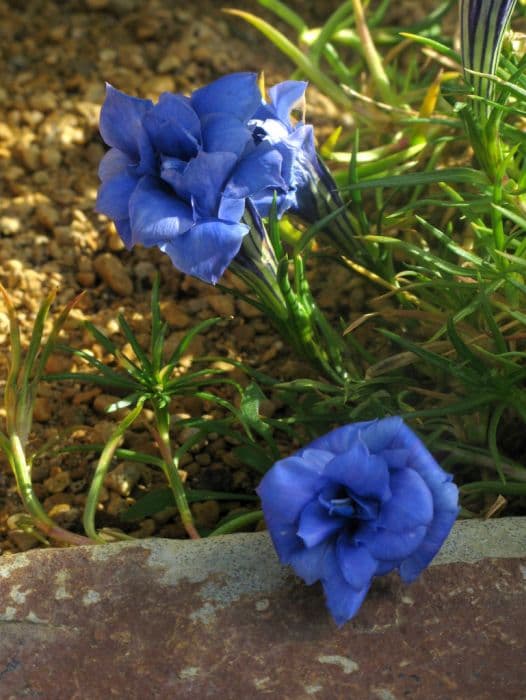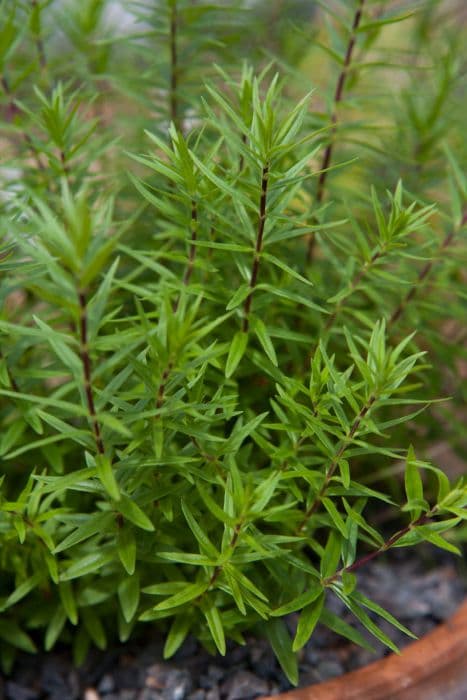Showy Chinese Gentian Gentiana sino-ornata 'Starlight'

ABOUT
The Gentiana sino-ornata 'Starlight' is known more commonly as Chinese Gentian. This plant is admired for its striking appearance, which features beautiful trumpet-shaped flowers. The blooms are a vivid blue color, often with a distinctive and eye-catching pattern that can include spots or stripes. These florid touches enhance the visual appeal of the trumpet-like blossoms, making them a standout in the garden. The foliage is equally attractive, comprising lance-shaped, fresh green leaves that provide a lush backdrop for the brilliant blue flowers. The Chinese Gentian's overall form is neat and compact, presenting a tidy and dense mat of vegetation that serves as a ground cover when not in bloom. The blooms typically appear during the cooler seasons, bringing a splash of color to gardens when many other plants have finished their display.
About this plant
 Names
NamesFamily
Gentianaceae
Synonyms
Showy Chinese Gentian, Ornate Gentian, Starlight Gentian
Common names
Gentiana sino-ornata 'Starlight'.
 Toxicity
ToxicityTo humans
Gentian is generally considered safe for humans when consumed in small amounts, such as those typically found in foods or beverages. However, consuming large amounts of any part of the plant, especially for medicinal purposes, could potentially lead to side effects. These side effects might include digestive complaints like nausea, vomiting, and diarrhea. Rarely, more severe reactions could occur due to overconsumption or sensitivity, but there is no well-documented case of severe toxicity in humans from casual contact or ingestion of gentian.
To pets
Gentian is not commonly listed as a toxic plant to pets. It is generally considered non-toxic to cats and dogs. Therefore, if a pet ingests a small amount of gentian, it is unlikely to experience any significant symptoms of poisoning. Nevertheless, ingestion of any non-food plant material can potentially cause mild gastrointestinal upset in some pets, which may result in symptoms like vomiting or diarrhea. If you observe any adverse reactions after your pet has ingested part of a gentian plant, it is advisable to contact your veterinarian.
 Characteristics
CharacteristicsLife cycle
Perennials
Foliage type
Deciduous
Color of leaves
Green
Flower color
Blue
Height
1 foot (30 cm)
Spread
1 foot (30 cm)
Plant type
Herb
Hardiness zones
6
Native area
China
Benefits
 General Benefits
General Benefits- Ornamental appeal: Adds striking blue-violet flowers to gardens, particularly effective in rock gardens or alpine settings.
- Low maintenance: Once established, it requires minimal care other than occasional watering during severe droughts.
- Drought resistance: Adapted to survive with minimal water, making it suitable for xeriscaping and water-conservation landscapes.
- Cold hardiness: Resilient to cold temperatures, making it ideal for gardens in cooler climates.
- Attracts pollinators: Flowers attract bees and butterflies, encouraging pollination of surrounding plants.
- Compact growth: Its small size makes it suitable for borders, containers, or small garden spaces without overpowering other plants.
- Deer resistance: Generally not preferred by deer, reducing the likelihood of damage in areas with active deer populations.
- Long blooming period: Provides color and interest in the garden with a blooming period from late summer to fall.
- Suitable for rockeries: Its natural habitat is rocky slopes, so it thrives in rock gardens and enhances their aesthetic.
 Medical Properties
Medical PropertiesThis plant is not used for medical purposes.
 Air-purifying Qualities
Air-purifying QualitiesThis plant is not specifically known for air purifying qualities.
 Other Uses
Other Uses- Garden photography subject: Gentiana sino-ornata 'Starlight' is often used by photographers to add vibrant color and visual interest in garden photography due to its bright blue flowers.
- Bonsai: With its compact growth habit, the Blue Gentian can be trained as a bonsai, providing an unusual and striking miniature representation of a natural landscape.
- Artistic inspiration: Artists may use Blue Gentian as a muse, drawing inspiration from their vivid hue and intricate flower shape for paintings, illustrations, and textile designs.
- Educational tool: In botanical studies, the Blue Gentian can be used to educate students about alpine plant adaptations and pollination biology.
- Winter garden interest: When left untrimmed, the dried seed heads of Blue Gentian can add texture and interest to a winter garden.
- Ice lantern decoration: The flowers can be frozen into ice lanterns, creating beautiful and natural decorative elements for outdoor winter events.
- Natural confetti: When the petals are dried, they can be used as biodegradable confetti for celebrations and eco-friendly events.
- Eco-printing: Leaves and flowers of Blue Gentian can be used in the eco-printing process on fabrics to transfer their patterns and colors naturally.
- Plant dye: The petals of the Blue Gentian may be used to create a natural dye for small-scale fabric dyeing projects, yielding shades of blue and purple.
- Botanical jewelry: The small size and striking appearance of the Blue Gentian blooms make them suitable for encapsulating in resin to create unique pieces of botanical jewelry.
Interesting Facts
 Feng Shui
Feng ShuiThe plant Gentian is not used in Feng Shui practice.
 Zodiac Sign Compitability
Zodiac Sign CompitabilityThe plant Gentian is not used in astrology practice.
 Plant Symbolism
Plant Symbolism- Determination: The Gentian flower is known for its ability to survive and thrive in difficult conditions, symbolizing persistence and the will to overcome challenges.
- Victory after Struggle: Gentians, due to their hardy nature, represent achieving success following a period of hardship, much like how they endure and bloom in harsh environments.
- Love and Attraction: With its striking blue colors, Gentians are often associated with attraction and deep feelings of love, symbolizing a profound and steadfast emotional connection.
 Water
WaterWater the Chinese Gentian moderately, providing enough water to keep the soil consistently moist but not waterlogged. During the growing season, water the plant with approximately 1/4 gallon of water every week, adjusting for rainfall and temperature, making sure not to let the soil dry out completely. In winter, reduce watering to every other week or less, depending on the plant's dormancy and indoor air humidity. Overwatering can lead to root rot, so ensure good drainage and water less frequently if the plant is not in active growth.
 Light
LightChinese Gentian thrives in bright, indirect light with some direct morning sun. Avoid placing it in full afternoon sun, which can be too intense and may cause leaf scorch. A spot near an east-facing window or a location that receives dappled sunlight throughout the day is ideal for ensuring the plant receives sufficient light without being overwhelmed.
 Temperature
TemperatureChinese Gentian prefers cool to moderate temperatures, ideally between 50 to 70 degrees Fahrenheit. It can tolerate short periods of colder temperatures down to 40 degrees Fahrenheit, but prolonged exposure to temperatures below this can be harmful. Similarly, the plant should be protected from extreme heat above 80 degrees Fahrenheit to prevent heat stress.
 Pruning
PruningPruning the Chinese Gentian is mainly done to remove dead or faded flowers and to shape the plant. Lightly prune after blooming has finished, usually in late fall. This encourages bushier growth and prepares the plant for its next flowering cycle. Pruning is not frequent and should be carried out only as needed for maintaining a neat appearance.
 Cleaning
CleaningAs needed
 Soil
SoilGentiana sino-ornata 'Starlight', commonly known as Chinese Gentian 'Starlight', thrives best in a soil mix that is well-draining and rich in organic matter. The ideal soil pH for Chinese Gentian 'Starlight' should be slightly acidic to neutral, between 6.0 and 7.0. A soil mixture containing peat moss, perlite, and a small amount of sand can provide the necessary drainage and support for the plant.
 Repotting
RepottingChinese Gentian 'Starlight' does not require frequent repotting and can be done every 2 to 3 years or when the plant has outgrown its pot. Repotting should be done in the spring before the growing season starts.
 Humidity & Misting
Humidity & MistingChinese Gentian 'Starlight' prefers moderate to high humidity levels, ideally between 50% to 70%. Avoid placing the plant in overly dry environments where humidity is too low to maintain its health.
 Suitable locations
Suitable locationsIndoor
Keep in well-draining soil, indirect light, and water when dry.
Outdoor
Plant in partial shade, moist, but well-drained soil.
Hardiness zone
6-9 USDA
 Life cycle
Life cycleThe life cycle of Gentiana sino-ornata 'Starlight', commonly known as Chinese Gentian, begins with seed germination, typically occurring in spring under cold conditions, a process that can be slow and erratic. After germination, the seedlings develop into a rosette of leaves at ground level in their first growing season. The plant will enter a vegetative stage, during which it grows and matures, and this may take a few years before it reaches flowering maturity. Once mature, Chinese Gentian 'Starlight' produces vivid blue, trumpet-shaped flowers during the late summer to autumn period. After flowering, seeds are produced and dispersed, completing the reproductive cycle. The plant then returns to a period of dormancy during the winter months, where it survives as a perennial rootstock, ready to regrow in the following spring.
 Propogation
PropogationPropogation time
Spring-Summer
Propogation: The Gentiana sino-ornata 'Starlight', commonly known as Starlight Gentian, is typically propagated through division, a popular method that offers a straightforward way to create new plants. This process is best performed in early spring as new growth begins, which provides the young plants with a full growing season to establish themselves. To propagate by division, the gardener should gently lift the parent plant from the ground and carefully separate the crowns or clumps by hand or with a knife, ensuring that each division has a portion of the root system intact. Once divided, the new plants can be immediately transplanted to a well-prepared garden site, keeping the soil moist until the plants are well-established. The divisions should be spaced about 12 inches (approximately 30 centimeters) apart to allow enough room for growth. This method of propagation ensures the new Starlight Gentian plants will be true to the parent in terms of their ornamental characteristics and vigor.









